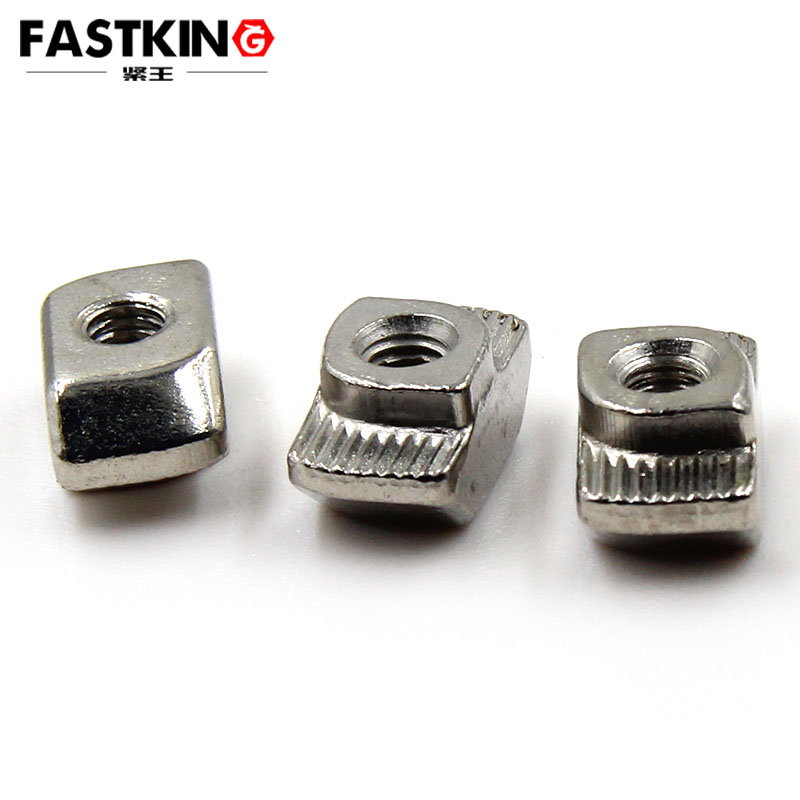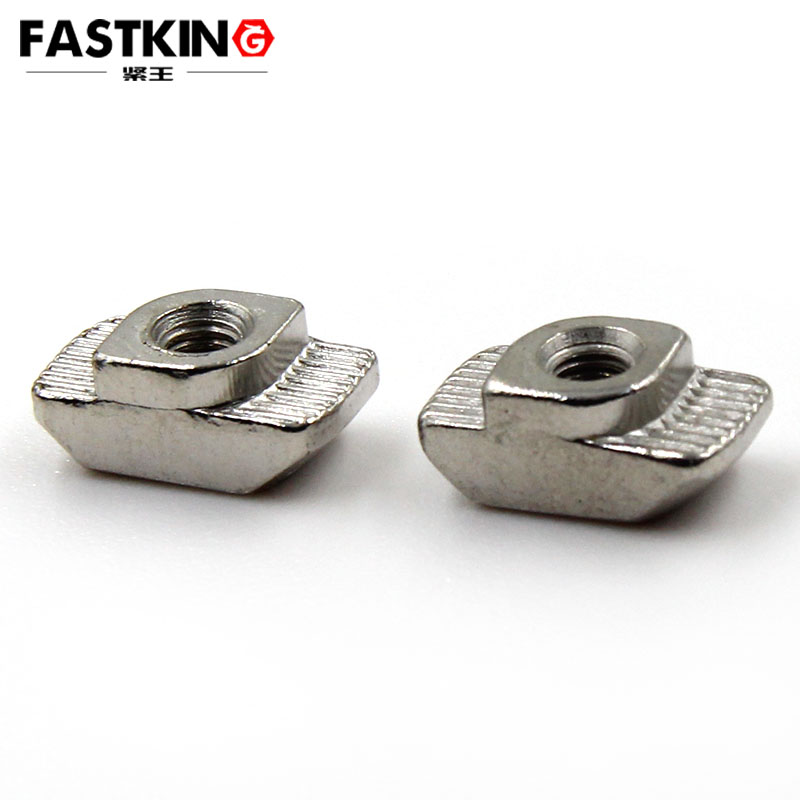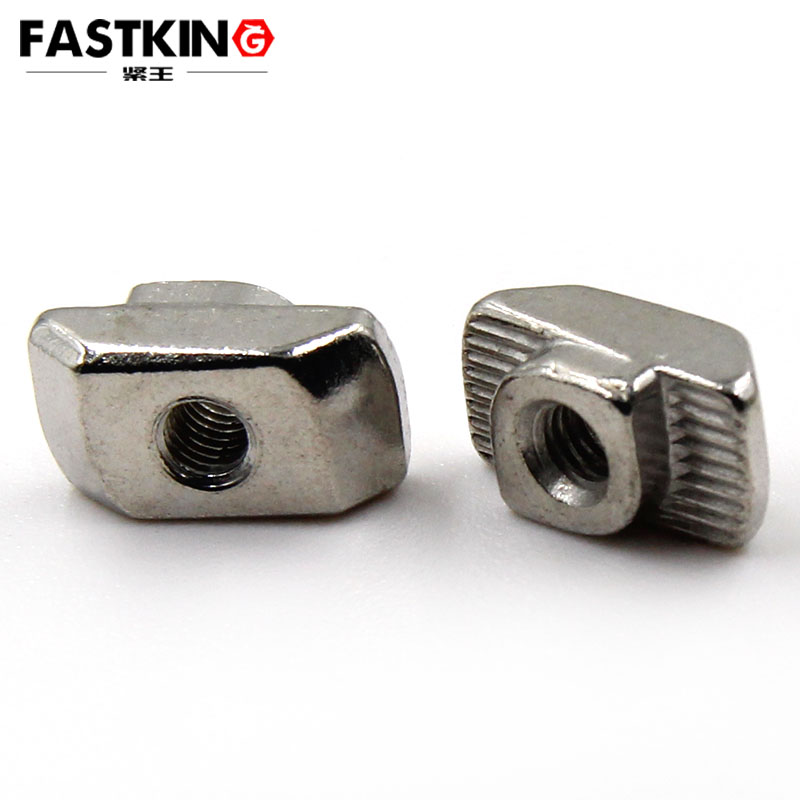

The "T"-shaped structure of the fixed T-nut for aluminum profiles is the key to its compatibility with aluminum profiles. The head of such nuts is in a horizontal T-shape, which perfectly fits the T-slots on the surface of aluminum profiles — standard T-slots are prefabricated on aluminum profiles during production, and the width of the slot opening is precisely matched with the width of the T-nut head. The tail of the nut is equipped with an internal threaded hole, which can be used in conjunction with bolts to achieve fastening. Unlike ordinary hexagon nuts that require external tools for fixation, the T-shaped head of the T-nut can be directly embedded into the T-slot of the aluminum profile. After embedding, it can slide along the slot to adjust its position. Once aligned with the installation point, the axial force generated by tightening the bolt makes the nut head fit tightly against the slot wall, forming a stable connection structure. This design not only eliminates the need for drilling and tapping on the aluminum profile but also allows flexible adjustment of the connection position, greatly improving the assembly efficiency and modifiability of the aluminum profile frame.
The core advantages of fixed T-nuts for aluminum profiles are concentrated in three characteristics: "no processing required", "high compatibility", and "strong stability". Firstly, the advantage of "no processing required": when connecting traditional aluminum profiles with ordinary nuts, it is necessary to first drill holes and tap internal threads on the profiles, which is not only time-consuming and labor-intensive but also may cause hole position deviation due to processing errors, affecting assembly accuracy; however, T-nuts can be directly embedded into the prefabricated T-slots without any additional processing on the aluminum profiles. This not only protects the integrity of the aluminum profiles but also shortens the assembly cycle, making them particularly suitable for large-scale frame construction scenarios. Secondly, the "high compatibility" feature: the specifications of T-slots for aluminum profiles on the market have formed industry standards (such as the common 20-series, 30-series, and 40-series aluminum profiles, which correspond to T-slots of different widths). T-nuts are also launched with matching specifications, ranging from M3 to M12 in thread size and from regular thickness to ultra-thin versions, which can accurately match different types of aluminum profiles and meet diverse connection needs. Finally, the "strong stability" performance: after the T-nut is embedded in the T-slot, the radial clamping force generated when the bolt is tightened firmly locks the nut head in the slot. Even when subjected to lateral tension or vibration loads, it is not prone to displacement; some T-nuts are also designed with anti-slip patterns on the head or made of elastic materials to further enhance the friction with the slot wall, avoiding loosening caused by vibration after long-term use and ensuring the stability of the frame structure.
In practical application scenarios, fixed T-nuts for aluminum profiles can be found in various fields. In the field of industrial automation, the racks of automated production lines and equipment guardrails are mostly built with aluminum profiles. T-nuts can be used to fix accessories such as motor brackets and sensor mounting plates — workers only need to embed the T-nut into the aluminum profile slot, slide it to the specified position, and then connect the accessory to the nut with a hexagon socket bolt to complete the installation. If it is necessary to adjust the position of the accessory later, it is only necessary to loosen the bolt to slide the nut without disassembling the entire frame. In the field of display stands and shelves, commercial product display stands and light-duty warehouse shelves are often made of aluminum profiles. T-nuts can connect components such as laminates and hooks. Their slidable feature allows flexible adjustment of the laminate height according to the size of the product, and there is no need to worry about profile damage caused by drilling, which extends the service life of the display stands. In the field of laboratory and medical equipment, aluminum profile frames are widely used due to their corrosion resistance and easy cleaning. The processing-free installation method of T-nuts can avoid damage to the profile surface, reduce dirt accumulation, and meet the cleanliness requirements of laboratory and medical scenarios. In addition, in new energy equipment (such as photovoltaic brackets and energy storage cabinet frames), T-nuts are also commonly used for connecting aluminum profiles and metal accessories, and their stability and weather resistance can meet the usage requirements in outdoor or complex environments.
To give full play to the performance of fixed T-nuts for aluminum profiles, correct installation methods and selection strategies are crucial. During installation, it is necessary to first confirm the specifications of the T-slot of the aluminum profile (such as slot width and slot depth) and select a T-nut of matching size — if the nut head is too wide, it cannot be embedded into the slot; if the head is too narrow, it is prone to shaking in the slot, affecting connection stability. When embedding the nut, it is necessary to keep the direction of the nut head consistent with the slot opening, push it gently into the slot, and then slide it along the slot to the installation position. Care should be taken to avoid excessive force that may deform the nut or scratch the slot wall. When tightening the bolt, the torque should be controlled according to the bolt specification and aluminum profile thickness, and the use of a torque wrench is usually recommended: insufficient torque will lead to insufficient fastening force and easy loosening; excessive torque may crush the aluminum profile slot wall or cause thread stripping of the nut. After installation, it is necessary to check whether the nut fits tightly against the slot wall and whether the accessory has no shaking to ensure a reliable connection.
In terms of selection, in addition to matching the aluminum profile specifications, it is also necessary to select the appropriate material and type according to the application scenario. From the perspective of materials, common T-nuts include three types: galvanized carbon steel, stainless steel (304/316), and nylon: galvanized carbon steel models have low cost and are suitable for indoor dry environments, such as equipment racks and display stands; stainless steel models have excellent corrosion resistance and are suitable for outdoor, humid, or corrosive environments, such as photovoltaic brackets and chemical equipment frames; nylon models are lightweight and have good insulation properties, making them suitable for electronic equipment, laboratory frames, and other scenarios that require insulation. From the perspective of types, in addition to conventional T-nuts, there are also "elastic T-nuts" with springs — the head of this type of nut has a built-in spring, which automatically presses against the slot wall after being embedded in the slot, effectively preventing the nut from sliding before the bolt is tightened, and is particularly suitable for the installation of vertical or inclined aluminum profiles; there are also "square T-nuts" with a square head structure, which have stronger anti-torsion capabilities and are suitable for connection scenarios that bear large torques.
As a core component of the aluminum profile connection system, although fixed T-nuts for aluminum profiles are small in size, they have changed the assembly mode of aluminum profiles — they do not require damage to the profile structure or complex processing, and achieve a balance between flexibility and stability through the "embedded" design. In the current era where industrial manufacturing is developing towards "modularization, rapidization, and lightweight", T-nuts, with their compatibility and practicality, have not only become a "standard component" for aluminum profile frame assembly but also play an important role in improving equipment assembly efficiency and reducing production costs. In the future, with the continuous expansion of the application fields of aluminum profiles, T-nuts will also be upgraded towards higher precision, stronger weather resistance, and more convenient installation, continuing to provide reliable support for the aluminum profile connection system.



